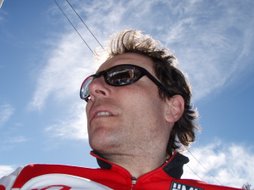After reading various bits and pieces on the web, which mostly pertained to muscle cars and motor bikes, i finally got round to applying the artwork to my new carbon frame. What was clear to me was that i needed to first wear away the original clearcoat such that the new clearcoat would have a suitably rough surface to which to adhere. The downside as far as i could guess is that maybe the decals would adhere less well to such a surface. I had 2 grades of emery paper at my disposal - 800 grain (relatively course) and 1200 grain (the finest i could find, although 1500 exists, but not at Bunnings). Surprisingly little effort is required in this regard. As most of us know, bike frames are easily scratched. Stickers went on fine.
Now for the tricky bit. I opted for an auto acrylic clearcoat lacquer - well, that's what the shop had, as opposed to the more tricksy 2pac option (potentially very toxic if inhaled). What was unclear to me (forgive the pun) was how many layers of clearcoat would be required, how often and how heavily they should be applied etc.
Nothing like just giving it a go. Disaster. In hindsight i applied way too much, the result being runs in the lacquer (unsightly), frothing in places (nozzle too close) and even more disturbingly, lifting of the decals, which are presumably made of vinyl. The lacquer's organic solvent (dimethyl ether) softened the decal adhesive, resulting in localised lifting and rippling. This thing was going to look awful. Once the clearcoat was dry to touch, i squashed the decals back into place as best i could and hung the thing up to cure, whilst contemplating ordering stickers all over again and getting it professionally done (for effectively 1/2 the price of a new frame).
Petrol-head to the rescue. Under GKs instruction, wet-sanded everything back - much more efficient and smoother than dry sanding. Removed the frothing, flattened the runs etc, and was able to remove some of the ugglyness of the bad sectors of decals. Some removal of decal edges was inevitable, but perhaps this thing was salvageable after all. Re-applied clearcoat - very light layers this time, applied a few minutes apart. Time will tell, but at present i'm pretty happy with the result, and looking fwd to building it up.
Now for the tricky bit. I opted for an auto acrylic clearcoat lacquer - well, that's what the shop had, as opposed to the more tricksy 2pac option (potentially very toxic if inhaled). What was unclear to me (forgive the pun) was how many layers of clearcoat would be required, how often and how heavily they should be applied etc.
Nothing like just giving it a go. Disaster. In hindsight i applied way too much, the result being runs in the lacquer (unsightly), frothing in places (nozzle too close) and even more disturbingly, lifting of the decals, which are presumably made of vinyl. The lacquer's organic solvent (dimethyl ether) softened the decal adhesive, resulting in localised lifting and rippling. This thing was going to look awful. Once the clearcoat was dry to touch, i squashed the decals back into place as best i could and hung the thing up to cure, whilst contemplating ordering stickers all over again and getting it professionally done (for effectively 1/2 the price of a new frame).
Petrol-head to the rescue. Under GKs instruction, wet-sanded everything back - much more efficient and smoother than dry sanding. Removed the frothing, flattened the runs etc, and was able to remove some of the ugglyness of the bad sectors of decals. Some removal of decal edges was inevitable, but perhaps this thing was salvageable after all. Re-applied clearcoat - very light layers this time, applied a few minutes apart. Time will tell, but at present i'm pretty happy with the result, and looking fwd to building it up.
Attack of the dreaded wrinkles
Take two
Four final coats in toto
Time to build
The Mudge's frame in prep. This was sprayed late in the day. The cooler temp results in a dull sheen. Wrinkle-free. Next weekend another sand-back before final light clearcoat in the middle of the day which will result in a high gloss finish to match the rest of the frame, although i quite like the matt finish.


















